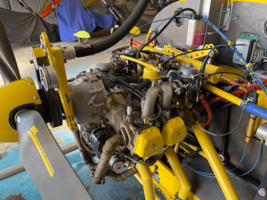(a) Major alterations
(1) Airframe major alterations. Alterations of the following parts and alterations of the following types, when not listed in the aircraft specifications issued by the FAA, are airframe major alterations:
(i) Wings.
(ii) Tail surfaces.
(iii) Fuselage.
(iv) Engine mounts.
(v) Control system.
(vi) Landing gear.
(vii) Hull or floats.
(viii) Elements of an airframe including spars, ribs, fittings, shock absorbers, bracing, cowling, fairings, and balance weights.
(ix) Hydraulic and electrical actuating system of components.
(x) Rotor blades.
(xi) Changes to the empty weight or empty balance which result in an increase in the maximum certificated weight or center of gravity limits of the aircraft.
(xii) Changes to the basic design of the fuel, oil, cooling, heating, cabin pressurization, electrical, hydraulic, de-icing, or exhaust systems.
(xiii) Changes to the wing or to fixed or movable control surfaces which affect flutter and vibration characteristics.
(2) Powerplant major alterations. The following alterations of a powerplant when not listed in the engine specifications issued by the FAA, are powerplant major alterations.
(i) Conversion of an aircraft engine from one approved model to another, involving any changes in compression ratio, propeller reduction gear, impeller gear ratios or the substitution of major engine parts which requires extensive rework and testing of the engine.
(ii) Changes to the engine by replacing aircraft engine structural parts with parts not supplied by the original manufacturer or parts not specifically approved by the Administrator.
(iii) Installation of an accessory which is not approved for the engine.
(iv) Removal of accessories that are listed as required equipment on the aircraft or engine specification.
(v) Installation of structural parts other than the type of parts approved for the installation.
(vi) Conversions of any sort for the purpose of using fuel of a rating or grade other than that listed in the engine specifications.
(3) Propeller major alterations. The following alterations of a propeller when not authorized in the propeller specifications issued by the FAA are propeller major alterations:
(i) Changes in blade design.
(ii) Changes in hub design.
(iii) Changes in the governor or control design.
(iv) Installation of a propeller governor or feathering system.
(v) Installation of propeller de-icing system.
(vi) Installation of parts not approved for the propeller.
(4) Appliance major alterations. Alterations of the basic design not made in accordance with recommendations of the appliance manufacturer or in accordance with an FAA Airworthiness Directive are appliance major alterations. In addition, changes in the basic design of radio communication and navigation equipment approved under type certification or a Technical Standard Order that have an effect on frequency stability, noise level, sensitivity, selectivity, distortion, spurious radiation, AVC characteristics, or ability to meet environmental test conditions and other changes that have an effect on the performance of the equipment are also major alterations.

